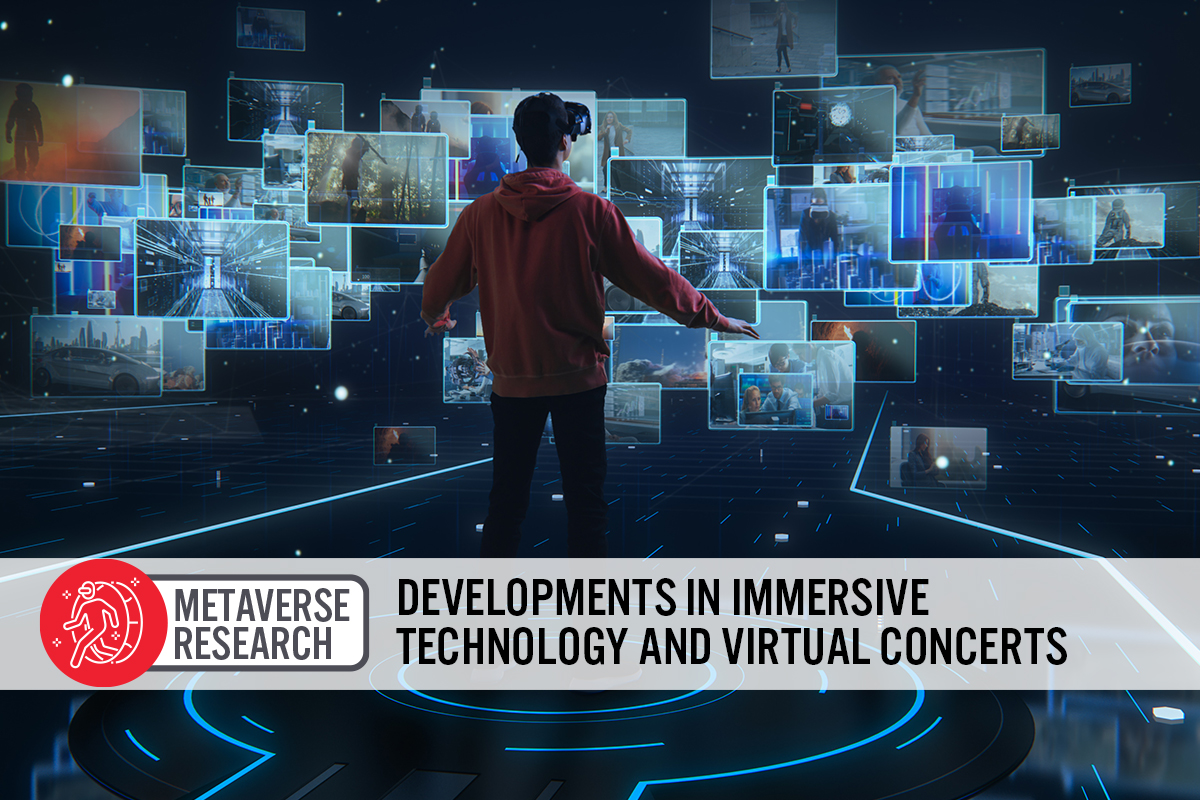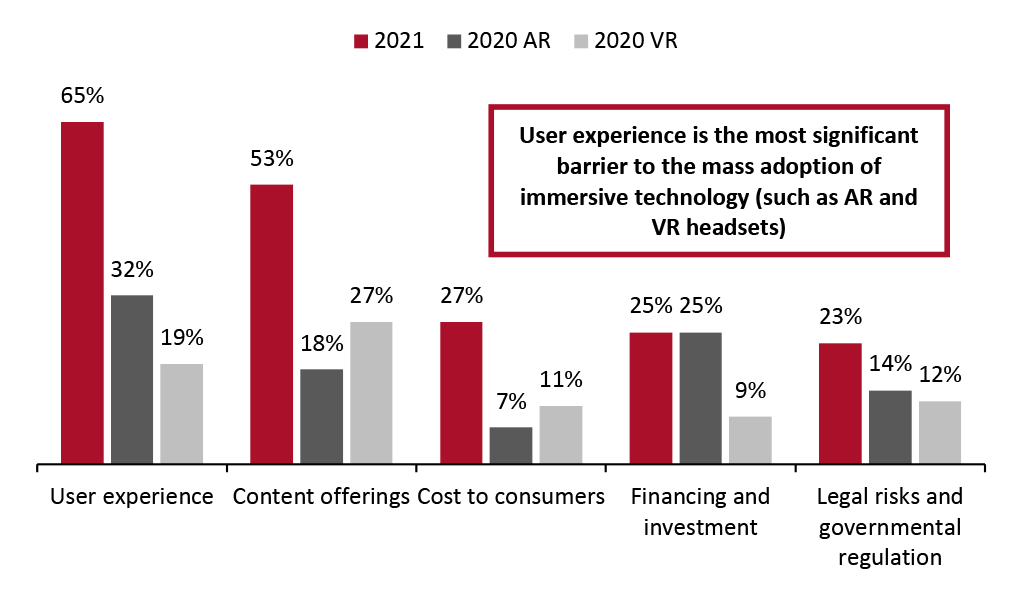
DIpil Das
Metaverse Latest
Metaverse technologies and virtual gaming have surged in popularity during the Covid-19 pandemic and are continuing to evolve, grow and converge each month. Coresight Research has identified the expanding metaverse as a key trend to watch in global retail in 2022 and beyond. Our Metaverse Latest series provides regular updates on metaverse developments, showing how key players and new entrants are seizing opportunities in the space. We also discuss metaverse trends we have seen recently. In this report, we present developments as of March 22, 2022.Recent Metaverse Developments
- On March 9, 2022, NFT game Dogami, a self-described “petaverse,” signed an agreement with The Sandbox to bring its NFT (non-fungible token) pets to the platform. This is a big step for interoperability, as Dogami is powered by Tezos and The Sandbox is powered by Ethereum. Dogami also purchased a plot of land for community experience.
- On March 9, 2022, gaming company Atari announced that it was moving forward with its plan to build a cryptocurrency-based casino in Decentraland, called Vegas City. Atari expects over $400 million in bets over a two-year period and is offering users the chance to hunt for NFT merchandise in the casino.
- On March 9, 2022, meat-stick brand Slim Jim filed trademarks under “Meataverse” and outlined plans to create a metaverse for customers to buy, sell and trade virtual meat and food products as NFTs. According to Slim Jim, it will continue exploring crypto-themed offerings.
- On March 9, 2022, The White House announced that US President Joe Biden had signed an executive order for a “whole-of-government” approach to digital assets, instructing agencies to answer specific questions about blockchain technologies.
- On March 10, 2022, automobile manufacturer Acura released a statement to announce that the first 500 customers to reserve a 2023 Acura Integra would receive a limited-edition NFT. Acura is also opening a digital showroom for the car’s debut, where customers can browse car features and explore digital Integra gear.
- On March 10, 2022, sneaker provider Skechers announced that it was launching an experiential store in Decentraland’s Fashion Street Estate, the fashion district. Instead of purchasing virtual land, Skechers is leasing 5,000 square feet of virtual space from metaverse real estate investor Metaverse Group.
- On March 10, 2022, Perfect Corp, an augmented reality (AR) fashion provider, launched a wearable NFT collection utilizing AR. Customers will be able to try NFT items such as jewelry and masks through lenses.
- On March 14, 2022, fashion retailer Diesel dropped an NFT collection through its own “D:verse” platform, a metaverse platform built as an NFT community for fans. The platform will host future metaverse projects, collaborations and strategies.
- On March 14, 2022, France-based sportswear retailer Lacoste announced a collaboration with Minecraft on a Spring and Summer 2022 collection that merges both brands. “Lacoste X Minecraft” offers a 360-degree wardrobe for real-world clothing accompanied by pixelated accessories for characters in Minecraft.
- On March 14, 2022, jewelry retailer Ambush partnered with digital creative agency Active Theory to release its first metaverse space, where users travel in a virtual spaceship to brand experiences, with the opportunity to purchase both digital and physical items. Ambush’s NFTs, which dropped in February 2022, will also be available in the space.
- On March 14, 2022, former Disney CEO Bob Iger joined the board of digital avatar company Genies, a popular platform for musical artists such as Jennifer Lopez and Rihanna. Genies is also partnered with Warner Music Group.
- On March 15, 2022, blockchain company Enjin released a new project, Efinity, a Layer 2 scaling solution for its original blockchain, Polkadot. The projected is dedicated to supporting high-volume NFT trade within Enjin’s blockchain gaming system, which includes popular play-to-earn game CryptoBlades.
- On March 15, 2022, payment company American Express filed several trademark applications indicating its plan to enter the metaverse with NFT-backed multimedia offerings, cryptocurrency services and virtual banking services.
- On March 15, 2022, blockchain startup ConsenSys raised $450 million in a joint investment from Microsoft, ParaFi Capital and SoftBank. Now valued at roughly $7 billion, ConsenSys was founded by one of Ethereum’s co-founders; its most popular product is MetaMask, a cryptocurrency wallet.
- On March 15, 2022, AR/VR headset provider Magic Leap revealed the features of its Magic Leap 2. In the new model, the over-the-head strap is optional, there are significant weight reductions and new tracking methods for improved speeds. Magic Leap continues to make steady improvements for user accessibility.
- On March 15, 2022, Verizon partnered with 30 Ninjas and France-based AR/VR studio Novelab and announced that they were working on an AR game, Adventure Thriller, which will fully utilize 5G ultra-wideband network to provide a superior immersive experience.
- On March 15, 2022, supercar manufacturer McLaren Automotive announced a partnership with metaverse infrastructure provider InfiniteWorld; it plans to provide digital experiences and release NFT artwork.
- On March 15, 2022, Amazon launched an online role-playing game designed to teach users cloud-computing skills, where avatars travel a virtual world and earn points by helping citizens solve cloud-related issues.
- On March 16, 2022, HSBC became the second large bank in the US to enter the metaverse, forming a partnership with The Sandbox. HSBC is hoping to expand its customer base by connecting to sports, esports and gaming enthusiasts.
- On March 16, 2022, robotics startup NexStem announced the general availability of NexStem headsets, which control devices through thought with brain-computer interfaces. This technology is even more so in its infancy than other metaverse technologies but represents an important step for immersion.
- On March 17, 2022, brewing company Heineken NV launched Heineken Silver, its first metaverse flavor, available exclusively in its Decentraland At the launch party, guests were able to interact with Heineken ambassadors, dine on virtual food and learn about how the flavor was created.
- On March 21, 2022, semiconductor giant Qualcomm launched a $100 million investment fund to jumpstart AR and VR technologies and develop metaverse infrastructure.
- On March 21, 2022, the CEO of technology giant Nvidia, Jensen Huang, announced a new superchip for building AI infrastructure. Nvidia is also releasing new sets of tools for creating virtual worlds through its 3D design platform, Omniverse.
- On March 21, 2022, Liquid Avatar Technologies, a fintech and immersive technologies company with a focus on digital identities, announced a physical payment card and loyalty program created specifically for the metaverse, where customers can earn points by participating in metaverse activities. The “LQID” card is aimed at increasing metaverse traffic to Aftermath Islands.
Trends We’ve Seen Recently
1. Headsets Are Constantly Improving AR, VR and mixed-reality technologies have been “emerging” technologies for quite some time; their development and adoption have been slow. However, as blockchain gaming increases in popularity, AR and VR startups, as well as industry pioneers such as Meta (Oculus) and Magic Leap are investing heavily in the development of immersive technologies. In 1968, the first ever headset was created, named “The Sword of Damocles.” Cumbersome, heavy and hanging from the sealing, the headset was not user friendly. In 2012, Google released its highly anticipated smart glasses—which, compared to their other products, was a failure, because Google did not outline any practical use for the glasses. The biggest obstacle to the adoption of both AR and VR technologies is the user experience, according to a 2021 survey by Perkins Coie and the XR Association (see Figure 1).Figure 1: Top Five Barriers to the Mass Adoption of Immersive Technology [caption id="attachment_144245" align="aligncenter" width="700"]
 In 2021, respondents could select multiple options; in 2020, respondents were asked to select the biggest obstacle for each technology
In 2021, respondents could select multiple options; in 2020, respondents were asked to select the biggest obstacle for each technology Base: XR industry executives—164 surveyed in April 2021, 191 surveyed in February 2020
Source: Perkins Coie/XR Association [/caption] Technology companies continue to work to overcome issues in headset development and adoption. We outline recent notable developments below. Varjo Finland-based startup Varjo, which was founded in 2016 and has amassed $122.5 million in funding to date, according Crunchbase, is working to solve several challenges to wide-scale consumer adoption of headsets. In the first quarter of 2021, Varjo released its XR-3 and VR-3 headsets with several features improving immersion, speed and bulkiness.
- Comfort: Compared to predecessors, the XR-3 and VR-3 are roughly 40% lighter—a significant reduction to improve user friendliness. The headsets feature built-in cooling systems, a wider design and a fitted headband.
- Eye tracking: Varjo headsets feature some of the fastest and most accurate eye-tracking technologies. Foveat rendering reduces the workload of the headset by displaying images in peripheral vision at a lower quality.
- Lidar: Lidar (light detection and ranging) works similarly to radar, remotely sensing with lasers to measure distances. Using lasers which travel faster, lidar scans can create accurate 3D models that are photorealistic, rather than appearing as projected holograms. The technology also allows for depth perception and, in the XR-3 headset, enables the collection of real-time data to improve visuals such as by adding shadows and reflections.
- Pricing: Varjo XR and VR headsets are decreasing in cost with each model. The XR-3 costs $5,995, down from $9,995 for the XR-1. The VR-3 costs $3,395, down from $4,995 for the VR-2.
 Source: Varjo[/caption]
Meta
Meta Platforms has been heavily involved in immersive technologies since 2014, when it purchased Oculus. As one of the pioneers of the early metaverse, Meta has been investing heavily in Oculus, aiming to consistently and steadily improve immersion in the recently released Horizon Worlds virtual game, which can only be accessed through the headset (its largest hurdle).
[caption id="attachment_144247" align="aligncenter" width="700"]
Source: Varjo[/caption]
Meta
Meta Platforms has been heavily involved in immersive technologies since 2014, when it purchased Oculus. As one of the pioneers of the early metaverse, Meta has been investing heavily in Oculus, aiming to consistently and steadily improve immersion in the recently released Horizon Worlds virtual game, which can only be accessed through the headset (its largest hurdle).
[caption id="attachment_144247" align="aligncenter" width="700"] Oculus Quest 2
Oculus Quest 2 Source: Meta Platforms [/caption] Released in October 2020, Meta frequently releases updates for its Oculus Quest 2 to improve graphics, speed and user friendliness.
- Tracking (hand, keyboard, desk): In late 2019, Oculus became the first VR headset to offer hand tracking, in which the headset tracks users’ hands, allowing them to set down controllers and touch virtual objects. The headset also tracks keyboards, desks and couches in the real world, showing users a virtual representation of them in the virtual world and improving immersion.
- Air link: The air link wirelessly connects the Oculus headset to PC computers so that users can play the most popular games, only accessible on PC. Being attached to the PC with a wired headset limits freedom of movement and disrupts immersion.
- Voice commands: TheOculus headset also allows for several voice commands. Fully immersed in a virtual setting with hand controllers, a user can simply say “Hey, Facebook” to prompt the headset to listen to a set of instructions.
- Pricing: Access to Horizon Worlds can only be gained through Oculus, and Meta is making a strong effort to reduce its price. The original Oculus Quest was priced at $399 when it was released in late 2018. The Quest 2, released in late 2019, is being sold for $299.
Figure 2: Popular Virtual Concerts on Fortnite and Wave [wpdatatable id=1848 table_view=regular]
Sources: Press releases Travis Scott’s concert in Fortnite was wildly successful, drawing in a massive audience of over 12 million. The event generated $20 million in revenue from merchandise sales and advertising revenue, according to Forbes. The entire Astroworld tour, which this virtual experience was part of, generated $53.5 million in revenue (according to Yahoo News), meaning that just nine minutes of a virtual experience accounted for 37.4% of tour revenue. Travis Scott also posted the entire concert to his YouTube channel, and it has been viewed over 180 million times (as of March 21, 2022). Various news sources projected that Ariana Grande earned a far greater amount from her Fortnite event, and The Weeknd reportedly brought in $350,000 in merchandise sales from a limited-edition collaboration with TikTok, which he donated entirely to the Equal Justice Initiative. [caption id="attachment_144250" align="aligncenter" width="700"]
 Source: Travis Scott[/caption]
In blockchain-based virtual worlds, The Sandbox and Decentraland both have themed neighborhoods and districts dedicated to concerts and music.
One of the most well-known record labels, Warner Music Group, partnered with The Sandbox to launch its concert hall, where digital avatars will be created for some of their well-known artists to perform in the game.
In October 2021, Decentraland hosted The Metaverse Festival, a four-day long virtual music festival where users, customizing their avatars with the most fashionable digital apparel, enjoyed big-name artists such as DJs 3LAU and Deadmau5 in its Festival District.
[caption id="attachment_144252" align="aligncenter" width="700"]
Source: Travis Scott[/caption]
In blockchain-based virtual worlds, The Sandbox and Decentraland both have themed neighborhoods and districts dedicated to concerts and music.
One of the most well-known record labels, Warner Music Group, partnered with The Sandbox to launch its concert hall, where digital avatars will be created for some of their well-known artists to perform in the game.
In October 2021, Decentraland hosted The Metaverse Festival, a four-day long virtual music festival where users, customizing their avatars with the most fashionable digital apparel, enjoyed big-name artists such as DJs 3LAU and Deadmau5 in its Festival District.
[caption id="attachment_144252" align="aligncenter" width="700"] Deadmau5 concert in Decentraland
Deadmau5 concert in Decentraland Source: Festival District, Decentraland [/caption] Virtual concerts became a popular alternative for artists during the Covid-19 pandemic, when in-person events were not possible. However, because they are less resource- and cost-intensive to hold (choreography, lights, staff, event venue, etc.), they may be more profitable than traditional concerts and are most likely here to stay.